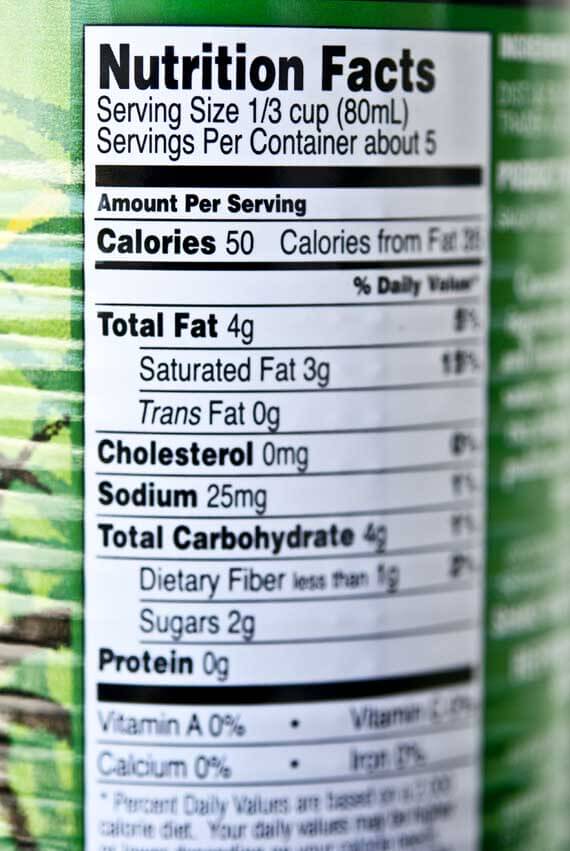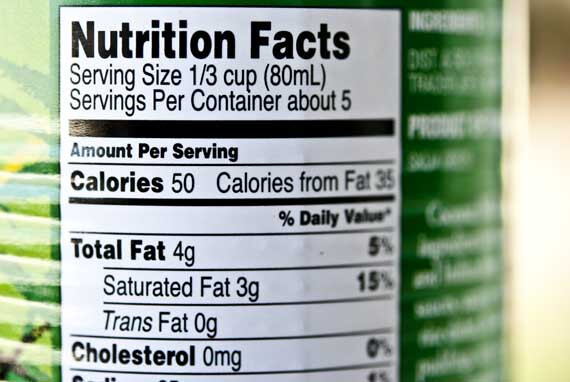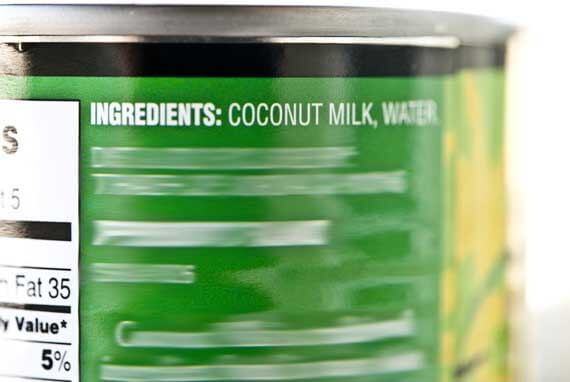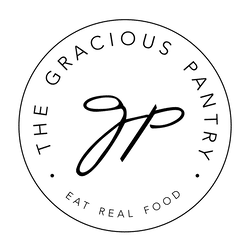Reading Labels For Clean Eating
A lot of people ask me about reading labels for clean eating. And the truth is, it’s a difficult topic to cover simply because there are soooooo many ingredients out there. It would be virtually impossibly for me to make a list of them all. So until now, I’ve avoided the subject.
But I’m not one to ignore questions, and I don’t like to leave people hanging. So I thought I would share the principle I used when learning to read labels for clean eating.
READING LABELS FOR CLEAN EATING:

NUMBER OF INGREDIENTS:
Many people believe that it’s the number of ingredients that matter. There is a theory out there than anything with more than 5 or 6 ingredients means the product is not clean. While I understand the thinking behind this, nothing could be further from the truth.
Most of my recipes have more than 5 or 6 ingredients and they are all considered clean in varying degrees (depending on your food philosophy).
You could have a food product with 30 ingredients, but if those ingredients are all clean and the item is not processed, it’s totally fine. Grant it, I don’t think you would ever find such an item, but go with me here…
READING LABELS:
This is how I did it in the beginning (and still do to some degree).
When looking at an ingredient list, consider each ingredient individually. Is it something you would buy separately to cook with in your own kitchen?
For example, let’s start with an random jar of spaghetti sauce. If the ingredients are, “tomatoes, garlic, olive oil and basil”, then you know it’s clean because you would buy JUST tomatoes to cook with. You would also buy JUST garlic to cook with. Same for olive oil and basil.
But if the ingredient list says, “tomatoes, garlic, olive oil, basil and maltodextrin”, you would want to pass it by. You would never go to the store for some maltodextrin to cook with at home.
Of course, there are always exceptions to the rule, but generally speaking, this will keep you pretty much on track. Word of warning though, it can also cause a bit of frustration when you start looking at labels this way. You have to hunt for clean products. They aren’t easy to find.
But then, that is the focus of clean eating, is it not? You want to purchase less packaged products and replace them with whole food items, mostly from the produce section. Foods that do not require labels because the ingredient list, IS the item itself.
EXAMPLES OF CLEAN FOODS:
(no labels required, for the most part)
- Oranges
- Celery
- Lettuce
- Chicken
- Plain oats
- Salmon
- Millet
- Barley
- Almonds
- Walnuts
These are all examples of what clean foods are. Think of it this way. You want to purchase INGREDIENTS. Not prepared foods.
Yes, this takes a bit of forethought and planning. Clean eaters do cook a lot, and most of them love it. Just know that over time, the cooking and prep work do become routine. Once you’ve done it for a while, you do it efficiently, quickly and really without any stress. It just becomes a part of the lifestyle.
A WORD ABOUT THE GRAMS AND PERCENTAGES:

Many people also ask me about the percentages you find on a food label (pictured above). These are the ones that tell you that a product has 54 grams of carbs, 50% of your vitamin C requirements for the day, or 30 grams of protein per serving.
This part of the label can be vital for many people, especially those with blood sugar issues and other medical problems. However, this part of the label will tell you NOTHING about whether an item is clean or not. So if clean eating is your goal, check the INGREDIENT LIST. Not the percentages. Those are used for other things.
I’ll use this can of coconut milk as an example. This is what you want to look at to determine if a product is clean (we’ll set aside the BPA issue right now for the purpose of the example):

You see in this example that the only thing in the ingredient list is coconut milk and water. Both are clean items, so this item is considered clean. (Again, BPA issues aside).
The percentages, are all together different. They tell you things like how many calories there are and how much vitamin A you are getting. While this is important information, it will not tell you if the item qualifies as clean.
So that, in a nutshell, is how I started. Once I had that down, I started educating myself on individual ingredients and what they are. I don’t know everything and I still scratch my head on a few items. But it really comes down to research and being willing to learn something new. You absolutely must educate yourself in order to eat clean. Will it happen overnight? No. Will you make mistakes? Plenty of them. But that’s all part of the learning curve. Just keep going. It will all become second nature after a while. I promise.
NEED SOME COACHING TO GET STARTED OR BACK ON TRACK?
These self-paced 8 lessons will guide you through getting started with clean eating. Enjoy access to 8 content pages with audio and downloads. Get more info here.
Article is an original work and is © Tiffany McCauley. It may not be reproduced for any reason without written permission by the author.


I am trying so hard to eat clean. My problem is I tend to eat the same things all the time and I also tend to skip meals, mainly lunch because I absolutely hate to cook so I like things that are quick so instead of just throwing peanut butter on a piece of bread or crackers I will just skip lunch. Also I work out of my car so finding something quick that I can carry with me is also hard. I also don’t like coconut, almonds or walnuts which are so good for you but I can’t stomach them. I am still trying hard to eat clean most of the time. I am just struggling with the fact that I hate to cook more than anything in the world.
Suzanne – You can absolutely customize your eating plan to fit what you do and don’t like, and while you may need to set aside some prep-time on the weekend, you don’t HAVE to do a ton of cooking. You can keep it very simple. Here’s a list with a lot of non-cook ideas. Maybe that will help: https://www.thegraciouspantry.com/clean-eating-school-lunches/
Thank you for this! I am really enjoying this process of learning how to “cook clean”. Thank you for all the tips!!
Jennifer – My pleasure! 🙂
Great post! There are so many terms out there, it can easily confuse someone. You made it simple: Buy ingredients, not prepared foods. Thank you!
Connie – My pleasure! 🙂
Thanks for this great article!
I thought I would add about a situation that infuriated me. Several years ago my husband had a heart attack which resulted in having to have a stint put in. During his hospital stay we met with a nutritionist. She said that even when a label says 0 trans fat…the government allows companies to add .5 grams of trans fat and still call it 0 trans fat. Are you kidding me?! So I am thinking it will be a long time before companies are forced to inform the consumers of any GMO.
Lisa – Yes, that’s very true. They even allow a certain percentage of rat feces in baby food. The state of our food supply pretty disgusting in this country. We just have to do the very best that we can. Let’s hope the Non-Gmo project gains some ground. It seems other states are finally catching on.
p.s. @GraciousPantry Thanks so much for your website!!! I began my clean eating and fitness journey to “Fit By 50”, on June 25th (when I turned 49 1/2 :), and I have resorted to your website for advice on numerous occasions. I’m loving your website, clean eating, fitness, my progress, and life in general! 🙂
FB50 – Thank you! (This says p.s. – did you leave another comment?)
I absolutely love this website – thank you so much for helping me and my family! I do have a question about Shakeology – is that considered clean?
AnnaMarie – There is not a single protein powder that is honestly clean. Why? You can’t walk out into a forest or a farm and pick it off a bush or tree, or pull it out of the ground. That being said, many clean eaters do use protein powder. And I would say that Shakeology is probably one of the better ones. A bit pricey, but a good option.
I am preparing to change my diet after Labor Day. I used to follow a fairly clean diet a few years ago, but I got off track and have slid into old bad habits as my lifestyle changed. I am trying to research some new things so that I can easily adapt them to my new busier schedule. I wonder about sodium and sugar. Do you think there is a “ceiling” for how high they should be? I would expect to find some salt and sugar in the ingredients of a sauce, but I am not sure what would be excessive.
I am enjoying your website! It is giving some new ideas and recipes to try. Thank You!
Sara – That’s a tricky question. The truth is, we would function just fine without any added sugar at all. But if you are looking at a spaghetti sauce, for example, there will be natural sugars in the tomatoes. This is why, generally speaking, clean eaters will look at the ingredient list instead of the percentages. It will tell you far more about the quality of what you are eating. As for salt, it’s a quality thing here too. You can google salt limits for adults and get a specific number. However, that doesn’t mean you should be eating that much. And if you are getting your salt primarily from packaged foods, it’s rarely, if ever, the good kind of salt (which we do need, just not in huge amounts). Not sure if this really answers your question though…
I am planning my first clean grocery trip for tomorrow. VERY nervous… I was wondering about ingredients. I understand the idea of buying ingredients that I would cook with, but being so new, I don’t even know what I would cook with… For example, triscuits ingredients are: whole grain soft white wheat, soybean oil, sea salt. But it wasn’t on your prepackaged list (I think you said due to the soybean oil.) I would have assumed soybean oil was safe… I have no idea what I’m doing. I’m just trying to make healthier choices (says the girl who is alive today thanks to pop-tarts and spaghetti-os). I just need you to tell me what to do. Please!?!?
ShawnaJ – I have shopping lists here on my blog if that helps, for several different stores. If you don’t have those stores near you, they will at least give you an idea of what to look for. A big part of clean eating is avoiding processed foods. You have to ask yourself, could you pick a Triscuit off a tree or bush in that form? The wheat yes, the actual cracker no. (Of course, there are exceptions to every rule, but you get the idea) Also, the more commercial a product is, the more likely it is to not be clean. Triscuits are very commercial. They are heavily processed and have soybean oil (which is a GMO – genetically modified organism). That means, the seeds were manufactured in a lab for the most part.
Don’t get overwhelmed. Honestly, if you buy something you think is clean only to find out later that it isn’t, that’s okay!! Nobody starts out being perfect, and nobody stays perfect once they get it figured out. It’s an 80-90% thing. If you shoot for perfection, you’re shooting for failure. Do the best you can, and as you learn more, make adjustments. It’s really that simple!
I also suggest watching the video in my sidebar here. It’s a good place to start. 🙂
Clean protein powder=hemp seed powder
I found it on line 15g clean protein per scoop
Enjoy
Erb – Not really. It’s still very processed.
Hey! Starting clean eating this week. Your website is awesome! What about salt? I know sodium intake should be kept lower but if I add a little salt to rice or if I buy a clean tomato sauce that has some salt added to it etc. Does it have to be sea salt? Or can I use just table salt (iodized salt is what I’ve always kept in my pantry)?
And what about something natural like citric acid (since it is in so many fruits and veggies) being added to preserve things? I think I saw it in (again) tomato sauce… or salsa maybe? Just trying to get off on the right foot. Thanks for all you are doing!
Meg – Salt is fine in moderation. Of course, the better quality the better it is, so to speak. But obviously you have to keep the overall intake low. Citric acid is a tough one. I’m still researching it myself. Some products actually say, “naturally occurring citric acid”. I’m pretty sure that’s okay. But if it just says citric acid, there seems to be some question about what it actually is. It’s vitamin c, yes. But I’ve read articles that say it’s GMO vitamin C or it’s highly processed. So it’s hard to really know what you’re getting. I find that if I stick to the glass jar product, there seems to be fewer additions of citric acid than the canned varieties. Hope that helps.
I shop mainly in the produce section because that’s all I really need to get since I am in college and live with my parents (they supply most of the food). But I know that when they buy canned vegetables it is not good so I think I am going to start buying those myself so they are fresh! I have a couple questions though…1. What are GMO’s? 2. Are the organic foods at the regular supermarket actually organic or should I start shopping at a wholefoods store? 3. Are packaged fruits in the produce section clean or should I buy the whole fruit. (I have been buying watermelon pre-cut)
Erin – GMO’s foods are foods that have been grown from GMO seed. Seeds that have been altered in a lab to readily accept the weed killer named Roundup. It’s a nasty business and best to avoid completely in my opinion. There have been no long term studies to prove their safety and the employees that worked for the corporation that makes these seeds now work at the FDA, allowing these big GMO corporations to have free reign. It’s pretty scary stuff. But people are fighting against it. More and more people are waking up and seeing that corporate profits and human health do not go hand in hand. For more information on how to avoid GMO’s and what companies have been certified GMO free, please visit the Non Gmo Project web site. They have a lot of information on that.
If something is labeled organic, it’s organic. It doesn’t matter where you buy them.
Precut fruits are just fine so long as they don’t add anything to them. Check for an ingredient list. If you don’t see one, it’s fine. If you do, read it very carefully. It should list ONLY the fruit you see in the package. Nothing else.
During my shopping, when I’m looking at labels…many items have “citric acid”, “lactic acid”, “xanthan gum”, “gum Arabic”, “guar gum”…are these considered processed? I’m assuming so, so I’ve tried to avoid items with these.
Thank you!
Lindsay – I can’t be certain, but I think it’s best to avoid them. I’ve read that some of those are not so good and heavily processed. Not to mention some of them come from GMO sources.
Elle… do you have that hot sauce recipe? I’d love to try it out!
Hello,
I just started the ” clean eating” life style and I have found your website so useful. Thank you !!
I have a few questions :
When it comes to reading labels I am trying to say at the 5 ingredients or less but sometimes it will say something like also contains less than 2 % of …… and will list more then 5 ( in addition to the original 5 ingredients )
Also I am unsure about the “Whole wheat “ vs. Whole grain ….. From what I have read/ seen whole wheat isn’t good correct ? Can you explain that a bit to me when it comes to the breads and pastas for clean eating what is the best way to go about that?
Gina – I’m not a believer in the 5 ingredient rule. If you are looking at a jar of clean spaghetti sauce that has tomatoes, garlic, onions, basil, oregano, marjoram and parsley in it… it would be kinda silly to put it back because it has more than 5 ingredients. I hope that makes sense.
If something is 100% whole grain, then it is clean (providing the other ingredients are clean too). Doesn’t matter what grain so long as it’s 100% whole grain.
Hope that helps,
Tiffany
Thank you so much for the info and education!!! It helps when your intent to eat more healthy but need a crash course on “How to shop” you made feel like I can actually succeed!!!
Debbie – You can! I think people get so overwhelmed with making a big change that they often make it harder than it needs to be. Clean eating is VERY simple and basic. You’ll do great!
Great information
Kassandra – Thanks!
What about fruit juices that’s concentrated? Are they clean?
Avil – As far as I know, yes. As long as there is no added sugar.
Great to know with me being on a budget and having to get a few things canned I will need to know this information.
Pat R – Great! I hope it proves useful! 🙂
Thank you for this! I am new to clean eating and am curious about ingredients like expeller pressed canola oil and vital wheat gluten – Are they clean?
Autumn – Here is a post I did on oils: https://www.thegraciouspantry.com/clean-eating-oils/
As for the vital wheat gluten, I have used it myself. I believe it to be clean, but I’m sure others could argue that point. So that’s really a personal decision.
Thank you so much for the awesome information. I’m brand new and trying to figure out a few things. Is a product containing “xanthan gum” considered clean? I know it can be bought, but I can’t find any exact info. What’s your opinion? Also Citric acid?
Jamie – Citric acid is not clean. All it is is vitamin C. However, when you see it listed in an ingredient list, it’s most likely to be made from fermented sugar, not taken from citrus fruits. As for xanthan gum, I have used it. In theory, it should be clean. But I have a feeling there is a considerable amount of processing involved, which is why I gave it up. I believe I’ve only used it in one recipe anyway. I think it’s one of those personal choice things. If you have use for it, and don’t mind using it, I say go for it. That alone isn’t going to destroy a clean eating plan. 🙂